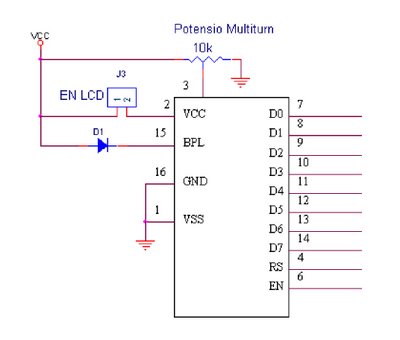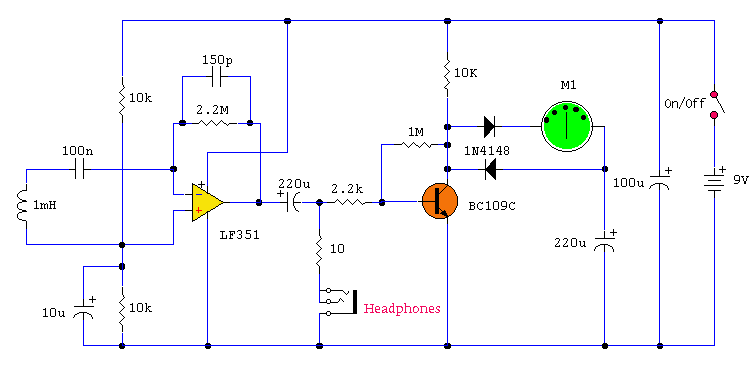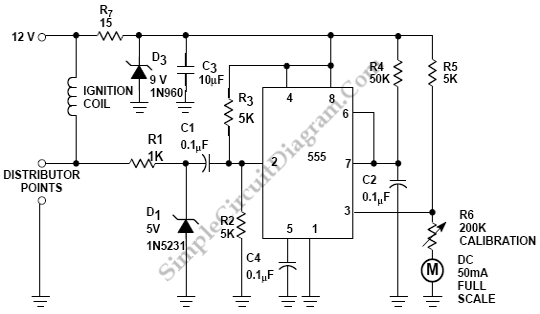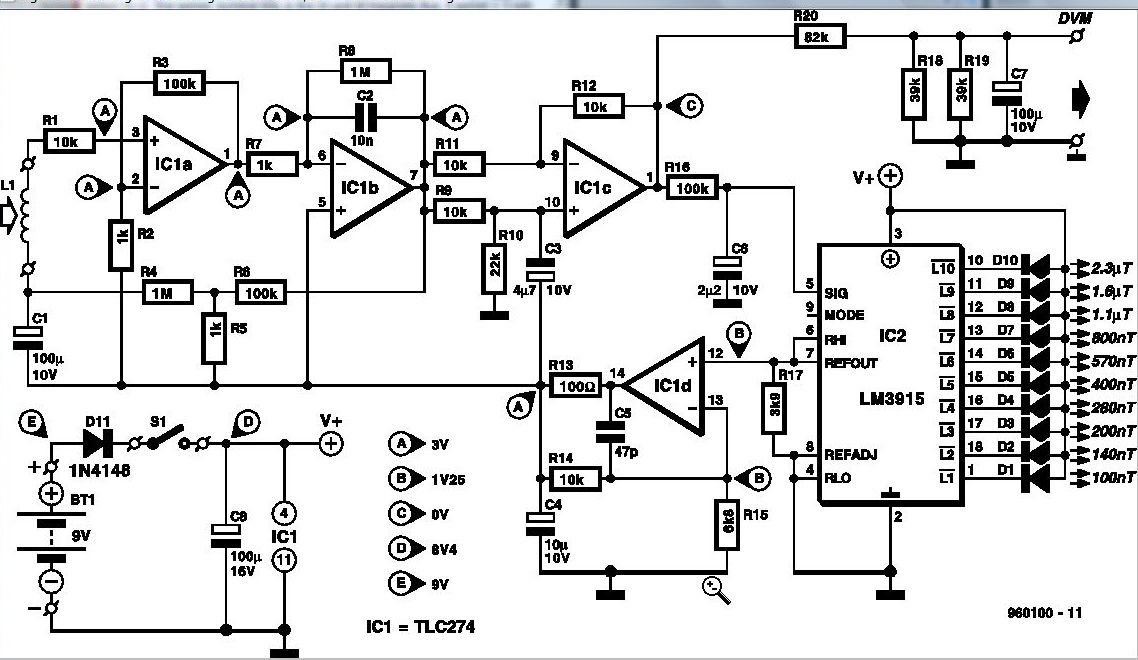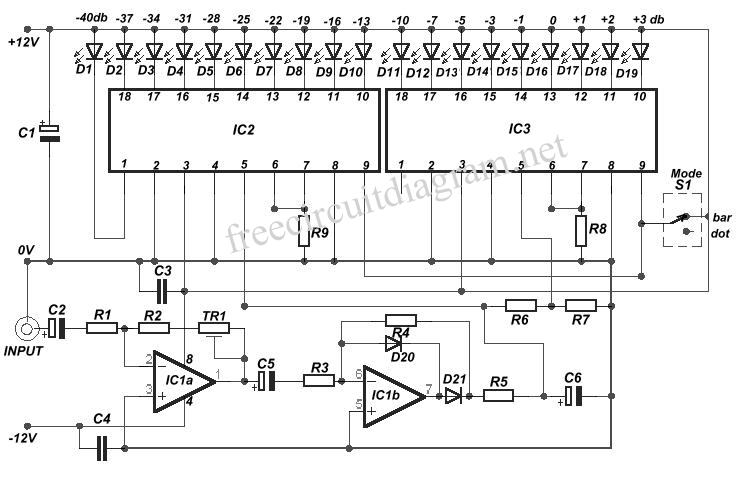
ESR Meter
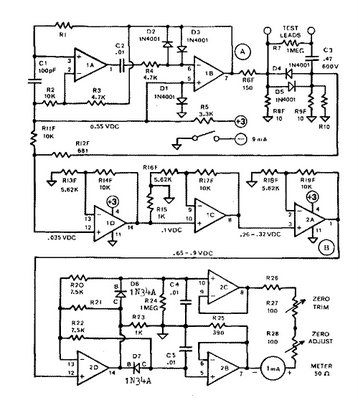
The ESR Meter functions as an AC Ohmmeter equipped with specialized scales and protective circuitry. It continuously measures the series resistance in electrolytic capacitors, operating at a frequency of 100 kHz to minimize the capacitive reactance factor. The series resistance primarily arises from the electrolyte between the capacitor plates, serving as an indicator of the capacitor's dryness state. Additionally, capacitor termination issues are easily identifiable due to the continuous ohmic reading. The ESR Meter utilizes eight operational amplifiers (op-amps). An op-amp is a theoretical basic amplifier with two inputs: a non-inverting input (+) that maintains an in-phase relationship with the output, and an inverting input (-) that exhibits an out-of-phase relationship. Op-amps are typically used with negative feedback, achieving stable operation when the two inputs equalize in voltage. Op-amps IA and IB create a regenerative 100 kHz oscillator circuit. Capacitor C1 acts as the primary timing capacitor, while resistor R1 is chosen to establish the frequency. Diodes D2 and D3 clip the upper and lower portions of the output waveform, ensuring that the output level and frequency remain stable despite variations in battery voltage. The output from op-amp IB drives a 10-ohm source resistor R8F. The test capacitor, through the test leads, couples this 100 kHz signal to a 10-ohm load resistor R9F. The voltage developed across this resistor is indicative of the capacitor's equivalent series resistance (ESR) value. The 10-ohm resistors are critical for determining the basic meter scaling. Capacitor C3 blocks any DC voltage present on the test capacitor. Diodes D4 and D5 protect the ESR Meter from initial charging currents to C3, while resistor R7 discharges C3 post-test. A DC operating bias of 0.55 V is established by diode D1 for the oscillator stage and subsequent DC-coupled stages operating in Class A. The DC bias from D1 and the ESR signal from R9F are combined at the input of op-amp ID, with both voltages amplified by op-amps ID, IC, and 2A, each having an amplification factor of approximately 2.8, determined by the feedback resistors R13F and R14F, among others. Op-amp 2D is configured as a peak-to-peak detector. When the incoming AC signal exceeds the normal bias level of about 0.77 V, the output of 2D also becomes positive, but must surpass the voltage drop across diode D6 to enable a fully equalized positive voltage to stabilize the op-amp via feedback through R20. Capacitor C4 charges to the peak value of the AC signal, accurately reflecting the peak of the incoming AC signal. The voltage drop across the diode becomes negligible due to the feedback process, allowing the circuit to function down to several millivolts. Resistor R21 provides a consistent minimum level of negative feedback around op-amp 2D, enhancing the op-amp's bandwidth and ensuring that the input-to-output phase shift remains low enough for proper circuit operation. The outputs from the peak-to-peak detector connect to two high-input-impedance unity-gain DC amplifiers, which drive the 1 mA meter movement differentially.
The ESR Meter's design incorporates essential components and configurations to ensure accurate measurements of capacitor performance. The use of operational amplifiers provides the necessary signal amplification and processing, while the oscillator circuit enables the generation of a stable test frequency. The careful selection of resistors and capacitors allows for fine-tuning of the measurement parameters, ensuring that the device can accurately reflect changes in the capacitor's equivalent series resistance. The inclusion of protective diodes and discharge resistors safeguards the circuit from potential damage due to voltage spikes or incorrect connections, enhancing the reliability of the ESR Meter in various testing scenarios. Overall, this meticulous design allows technicians and engineers to maintain and assess the health of electrolytic capacitors effectively, ensuring optimal performance in electronic circuits.The ESR Meter is basically an AC Ohmmeter with special scales and protective circuitry. It provides a continuous reading of series resistance in electrolytic capacitors. It operates at 100 kHz to keep the capacitive reactance factor near zero. The remaining series resistance is due to the electrolyte between the capacitor plates and indicates the state of dryness. Capacitor termination problems also show up plainly due to the continuous ohmic reading. The ESR meter uses 8 operational ainplifiers. An op-amp is an idealized basic amplifier with two inputs. The non-inverting input (+) has an in-phase relationship with the op-amp output, and the inverting input (-) an out-of-phase relationship. Op-amps are usually used with negative feedback and reach a stable operating condition when their two inputs are equal in voltage.
Op-amps IA & 1B form a regenerative 100 kHz oscillatnr circuit. Capacitor C1 is the basic tiining capacitor and RI is selected to set frequency. Diodes D2 & D3 clip the bottom and top of the output waveform so that the output level and frequency are resistant to battery voltage changes. The oscillator output of op-amp 1B drives 10-ohm source resistor R8F. The test-capacitor, thru the test leads, couples this 100 kllz signal to 10-ohm load resistor R9F. The amount of voltage developed here is indicative of the capacitors ESR value. (The 10-ohm resistors determine the basic iieter scaling. ) Capacitor C3 blocks any DC voltage present on the test-capacitor. Diodes D4 & D5 protect the ESR Meter from any initial charging current to C3. Resistor R7 discharges C3 after test. A DC operating bias of 0. 55 V is established by diode D1 for the oscillator stage and for all subsequent stages, which are DCcoupled and operated class A.
DC bias from D1 and ESR signal from R9F are combined at the input of op-amp 1D. Both voltages are amplified by 1D, 1C, & 2A. Each of these three stages has an amplification factor of about 2. 8 due to the ratio of output-voltage to feedback~voltage at the (-) input, which is determined -by feedback resistors R13F & R14F, etc. Op-amp 2D is configured as a peak-to-peak detector. when the in-corning AC signal goes more positive than the normal bias level of about 0. 77 Volt, the output of 2D also goes positive. But it must go positive enough to overcome the voltage drop across diode D6 before a fully equalizing positive voltage can be fed back to the -(-) input thru R20 to stabilize the op-amp.
-Capacitor C4 is charged to the peak value of the AC signal and accurately represents the peak of the incoming AC signal. The voltage drop across the diode becomes almost inconsequential due to the feedback process, and the circuit works down to a few mV.
Resistor R21 provides a constant minimum amount of negative feed-back around op-amp 2D. The negative feedback increases the op-amp bandwidth which, most importantly, keeps the amplifier input-to-output phase-shift low enough for proper circuit operation. The two outputs from the peak-to-peak detector are connected to two high-input-impedance unity-gain DC amplifiers, which drive the 1 mA meter movement differentially.
🔗 External reference
The ESR Meter's design incorporates essential components and configurations to ensure accurate measurements of capacitor performance. The use of operational amplifiers provides the necessary signal amplification and processing, while the oscillator circuit enables the generation of a stable test frequency. The careful selection of resistors and capacitors allows for fine-tuning of the measurement parameters, ensuring that the device can accurately reflect changes in the capacitor's equivalent series resistance. The inclusion of protective diodes and discharge resistors safeguards the circuit from potential damage due to voltage spikes or incorrect connections, enhancing the reliability of the ESR Meter in various testing scenarios. Overall, this meticulous design allows technicians and engineers to maintain and assess the health of electrolytic capacitors effectively, ensuring optimal performance in electronic circuits.The ESR Meter is basically an AC Ohmmeter with special scales and protective circuitry. It provides a continuous reading of series resistance in electrolytic capacitors. It operates at 100 kHz to keep the capacitive reactance factor near zero. The remaining series resistance is due to the electrolyte between the capacitor plates and indicates the state of dryness. Capacitor termination problems also show up plainly due to the continuous ohmic reading. The ESR meter uses 8 operational ainplifiers. An op-amp is an idealized basic amplifier with two inputs. The non-inverting input (+) has an in-phase relationship with the op-amp output, and the inverting input (-) an out-of-phase relationship. Op-amps are usually used with negative feedback and reach a stable operating condition when their two inputs are equal in voltage.
Op-amps IA & 1B form a regenerative 100 kHz oscillatnr circuit. Capacitor C1 is the basic tiining capacitor and RI is selected to set frequency. Diodes D2 & D3 clip the bottom and top of the output waveform so that the output level and frequency are resistant to battery voltage changes. The oscillator output of op-amp 1B drives 10-ohm source resistor R8F. The test-capacitor, thru the test leads, couples this 100 kllz signal to 10-ohm load resistor R9F. The amount of voltage developed here is indicative of the capacitors ESR value. (The 10-ohm resistors determine the basic iieter scaling. ) Capacitor C3 blocks any DC voltage present on the test-capacitor. Diodes D4 & D5 protect the ESR Meter from any initial charging current to C3. Resistor R7 discharges C3 after test. A DC operating bias of 0. 55 V is established by diode D1 for the oscillator stage and for all subsequent stages, which are DCcoupled and operated class A.
DC bias from D1 and ESR signal from R9F are combined at the input of op-amp 1D. Both voltages are amplified by 1D, 1C, & 2A. Each of these three stages has an amplification factor of about 2. 8 due to the ratio of output-voltage to feedback~voltage at the (-) input, which is determined -by feedback resistors R13F & R14F, etc. Op-amp 2D is configured as a peak-to-peak detector. when the in-corning AC signal goes more positive than the normal bias level of about 0. 77 Volt, the output of 2D also goes positive. But it must go positive enough to overcome the voltage drop across diode D6 before a fully equalizing positive voltage can be fed back to the -(-) input thru R20 to stabilize the op-amp.
-Capacitor C4 is charged to the peak value of the AC signal and accurately represents the peak of the incoming AC signal. The voltage drop across the diode becomes almost inconsequential due to the feedback process, and the circuit works down to a few mV.
Resistor R21 provides a constant minimum amount of negative feed-back around op-amp 2D. The negative feedback increases the op-amp bandwidth which, most importantly, keeps the amplifier input-to-output phase-shift low enough for proper circuit operation. The two outputs from the peak-to-peak detector are connected to two high-input-impedance unity-gain DC amplifiers, which drive the 1 mA meter movement differentially.
🔗 External reference
